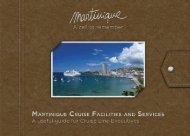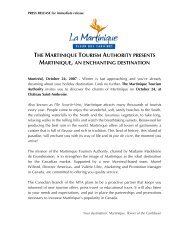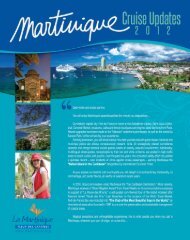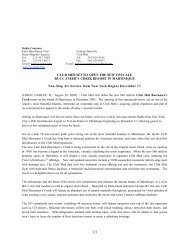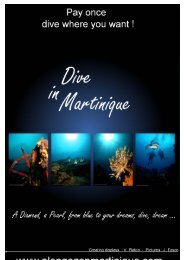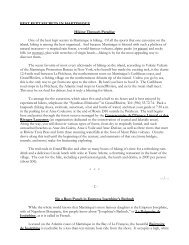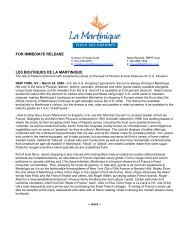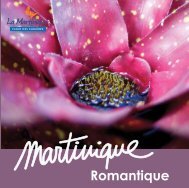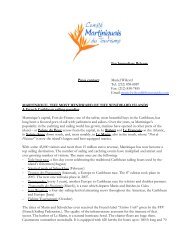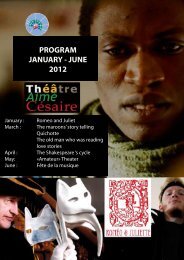Muriel Wiltord FOR IMMEDIATE RELEASE Tel - Martinique
Muriel Wiltord FOR IMMEDIATE RELEASE Tel - Martinique
Muriel Wiltord FOR IMMEDIATE RELEASE Tel - Martinique
You also want an ePaper? Increase the reach of your titles
YUMPU automatically turns print PDFs into web optimized ePapers that Google loves.
Press contact : <strong>Muriel</strong> <strong>Wiltord</strong><br />
<strong>FOR</strong> <strong>IMMEDIATE</strong> <strong>RELEASE</strong> <strong>Tel</strong> (212) 838 68 87- Fax (212) 838 78 55<br />
Email: muriel.wiltord@franceguide.com<br />
LA MARTINIQUE, A PRACTICAL GUIDE <strong>FOR</strong> THE AFRICAN-AMERICAN TRAVELER<br />
When African heritage experience matters<br />
Whether you are just planning to visit <strong>Martinique</strong> during a cruise or deciding to stay a while, <strong>Martinique</strong> will feel like<br />
family. The island’s population is 90% of African descent, and its colonial past marked by the plantation economy has<br />
a lot in common with the south of the United States.<br />
As an African-American traveler you will feel a special connection with the island’s cultural and historic heritage, and<br />
despite the language, you surely will find the similarities in experience striking.<br />
For those for whom black thinkers and writers are key to understand a culture, it is important to have in mind that<br />
<strong>Martinique</strong> is first and foremost the birthplace of Aimé Césaire and Frantz Fanon, the former, renowned poet and<br />
drama writer, who coined the term negritude, and the latter, author of Black Skin, White Masks, who led an<br />
anticolonial and antiracist struggle throughout his life. These two native sons of <strong>Martinique</strong> made great contributions<br />
to the current flowering of Diaspora literature.<br />
For sun worshippers and history buffs alike, searching to experience the Caribbean with a plus, <strong>Martinique</strong> has a lot to<br />
offer. It is the island with a French flair, where many cultures and people have come together: African, European,<br />
Indian, thus creating a rich heritage. The African influence can be found in both obvious and subtle ways: in the<br />
generosity of its cuisine, in the Creole language, in the beauty of the people.<br />
On the threshold of memory<br />
<strong>Martinique</strong> is one of the few islands which celebrates the abolition of slavery. May 22 is indeed a holiday and the<br />
occasion for celebrations throughout the island. Slavery was abolished in 1848, and May is the local black history<br />
month in <strong>Martinique</strong>.<br />
Many plantation estates have been converted into tourism attractions. Many will remind travelers of <strong>Martinique</strong>’s<br />
heavy and often difficult past:<br />
Habitation Céron in the northern village of Prêcheur is one of the oldest estate on the island which dates back from<br />
the 17 th century (1658). Worth the visit are the ruins from the old sugar factory, slave quarters and the beautiful<br />
tropical garden with the 250 year old samanae saman tree (or rain tree). If only trees could talk.<br />
Plantation Leyritz, probably the most important estate in the north of the island, created in 1770 has been a hotel<br />
since 1970. The planters house (masters’ house) still has an “aret neg”, a piece of iron which used to indicate where<br />
the slaves could not trespass. The slave cabins were converted into rooms and the hotel has been the site of a summit<br />
meeting between President Ford and President Giscard d’Estaing of France in the 70s.<br />
Habitation Clément in François, also features an historical plantation home, all furnished with colonial style antique<br />
mahogany furniture. With a working rum distillery, the visit is worth the while, and will take you back in time.
The year 1998 marked the 150 th commemoration of the abolition of slavery, and reminding of the celebrations that<br />
took place throughout the island are memorials and statues:<br />
Anse Cafard Slave Memorial in Diamant, is probably the most notable and striking: conceptualized and created by<br />
Martinican sculptor Laurent Valère, it is an ensemble of 20 colossal stone statues, overlooking the sea, as a<br />
reminiscence of that fatal night of April 7, 1830 when a slaves ship drowned, along with its cargo of men, women and<br />
children who were never to see the shores.<br />
Also in Diamant is the statue of the « maroon » saluting its new found freedom welcomes visitors at the entrance of<br />
the village.<br />
In Fort-de-France, the Schoelcher library, a historic monument, has been named after the French abolitionist deputy<br />
and human rights activist, Victor Schoelcher who campaigned to end slavery in the French West Indies. This<br />
Byzantine style library, was built in Paris at the same time as the Eiffel Tower, and shipped over, mosaic by mosaic, to<br />
<strong>Martinique</strong><br />
For those who want to know more about the plantation economy and life style, La Maison de la Canne museum in<br />
Trois-Ilets has an exhibit which retraces three centuries of history.<br />
But of course reminiscing is not all one can do in <strong>Martinique</strong>, and the island offers a wide choice of interesting<br />
activities, among others:<br />
Eco-visits: kayaking, visit of the mangrove, hiking, botanical gardens (for more information, see press release on<br />
ecotourism).<br />
Shopping: noteworthy: 18-karat gold Creole jewelry, all with names that recall the island’s link to its past: forçat<br />
necklace (slave chain), tétés négresse earings, beautiful feminine adornments, Creole earings. Most shopping is<br />
concentrated into downtown Fort-de-France, the capital city, but many malls in the outskirts offer a wide choice of<br />
boutiques and the latest in French fashion (for more information, see press release “Shopping in <strong>Martinique</strong>”).<br />
And last but not least, Creole food aficionados will be happily surprised by the similarities between the cuisine of<br />
Louisiana and the cuisine of <strong>Martinique</strong>. With more than 300 restaurants, there is no better way to understand the<br />
island’s soul than to taste its food.<br />
Did you know that…<br />
Accra, the tasty cod fish fritter, served as an appetizer in <strong>Martinique</strong>, homonym of the capital of Ghana, means<br />
« small fritter » in Woloff<br />
Béhanzin, the last king of Dahomey (now known as Benin) was exiled in <strong>Martinique</strong> after he fought the French for<br />
his kingdom.<br />
Béké is the local name for the descendents of the 1 st French settlers.<br />
Coffee was brought in 1720 onto <strong>Martinique</strong>. From this introduction, coffee was spread throughout the new world. By<br />
1777, 18 million coffee trees were growing on the island, progenitors of most coffee plants growing in the Caribbean,<br />
Central and South America today. The Coffee and Cocoa Museum is located at Domaine Chateau Gaillard in Trois-<br />
Ilets and presents a 1000 variety of coffee and cocoa plants.<br />
Laghia, is a dance of African origins. In 1931, Katherine Dunham who founded the Negro Dance Group in Chicago,<br />
Illinois, choreographed one of her most famous works, L’Ag’Ya (1938), based on a fighting dance of <strong>Martinique</strong> after<br />
travelling to the island.<br />
Euzhan Palcy, a native of <strong>Martinique</strong> is the first black female to have produced a feature lenght film in Hollywood,<br />
“A Dry White Season”, featuring and Marlon Brando. Her well known “Sugar Cane Alley” won the Silver Lion<br />
Award at the Venice Film Festival.<br />
Gombo is the word in <strong>Martinique</strong> for okra. According to the legend, some slaves carried the seeds of that plant from<br />
Africa with them.<br />
Habitation is the equivalent of a plantation home.<br />
Zouk chouv is the cousin of zydeco music.<br />
For further information, contact: <strong>Martinique</strong> Promotion Bureau, 444 Madison Ave, NY, NY 10022,<br />
<strong>Tel</strong>: (212) 838-6887, Fax:(212) 838-7855, E-mail: martiniquepress@franceguide.com – Website: www.martinique.org



